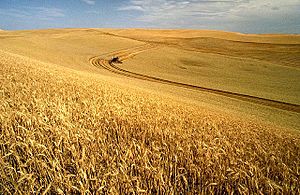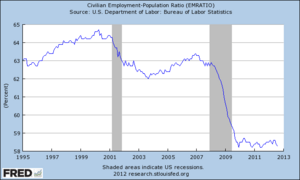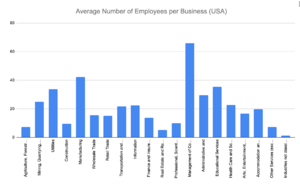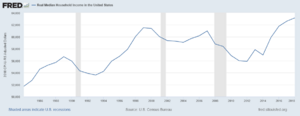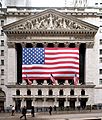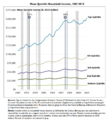Economy of the United States facts for kids
The economy of the United States is like a giant machine that produces goods and services for people. It's one of the biggest economies in the world! When we talk about the economy, we mean all the ways people earn money, spend money, and create things. This includes everything from making cars and computers to providing services like teaching and healthcare.
In 2019, the U.S. economy produced about $21.4 trillion worth of goods and services. This amount, called the GDP, is roughly a quarter of the entire world's economic output. The U.S. economy is known for its strong focus on services, like healthcare, education, and technology. It also has a lot of manufacturing, farming, and mining.
Contents
Understanding the U.S. Economy
The U.S. economy is a mixed economy. This means it combines elements of both capitalism (where businesses are mostly privately owned) and socialism (where the government plays a role). Most businesses are owned by individuals or companies, but the government also provides important services and sets rules.
How Big is the U.S. Economy?
The United States has the largest national economy in the world. Its total economic output, or GDP, is huge. This means a lot of goods and services are produced and traded within the country. It also means the U.S. plays a very important role in the global economy.
What Makes Up the Economy?
The U.S. economy is made up of many different parts.
- Services: This is the biggest part. It includes things like healthcare, education, finance, retail, and technology. Think of doctors, teachers, bankers, and people who work in stores or create apps.
- Manufacturing: This involves making things, like cars, airplanes, electronics, and machinery.
- Agriculture: This is farming, producing food like wheat, corn, and meat.
- Mining: This includes getting natural resources like oil, gas, and minerals from the ground.

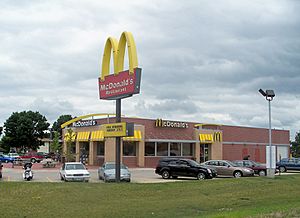
Key Economic Players
Many different groups help the U.S. economy run.
- Consumers: That's us! When people buy things, they help businesses grow.
- Businesses: Companies create jobs and produce goods and services.
- Government: The government collects taxes and spends money on things like roads, schools, and defense. It also sets rules for businesses.
- Banks: Banks help people save money and lend money to businesses and individuals.
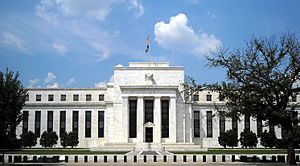
Jobs and Work in the U.S.
The economy creates millions of jobs for people. The types of jobs available change over time. For example, there are now more jobs in technology and healthcare than there used to be. The U.S. has a large workforce, and many people work in the service industry.
How People Earn Money
People earn money in many ways in the U.S. economy.
- Wages and Salaries: Most people earn money from their jobs.
- Business Profits: People who own businesses earn money from their profits.
- Investments: Some people earn money from investments, like stocks or real estate.
The amount of money people earn can vary a lot. This is called income inequality. The government and other groups often discuss ways to make income more fair for everyone.
Trade and Global Connections
The U.S. economy is very connected to the rest of the world.
- Exports: The U.S. sells many goods and services to other countries. These include airplanes, machinery, and technology.
- Imports: The U.S. also buys many goods from other countries, like cars, electronics, and clothing.
This global trade helps the U.S. economy grow and gives consumers more choices.
History of the U.S. Economy
The U.S. economy has changed a lot over time.
- Early Days: In the beginning, the economy was mostly based on farming.
- Industrial Revolution: In the 1800s, factories and machines became very important. This led to more manufacturing jobs.
- 20th Century: The U.S. became a global economic leader, especially after World War II. New industries like automobiles and electronics grew rapidly.
- Modern Economy: Today, the economy is heavily focused on services and technology.

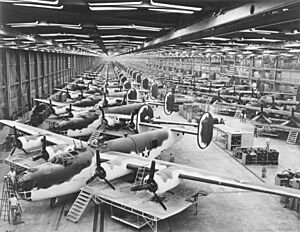
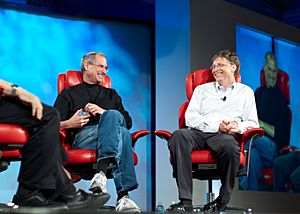
Images for kids
-
Oil wells at Los Angeles, California, 1905
-
U.S. share of income (pre-tax and after-tax) earned by top 1% households in 1979, 2007, and 2015 (CBO data). The first date (1979) reflects the more egalitarian pre-1980 period, 2007 was the peak inequality of the post-1980 period, and the 2015 number reflects the Obama tax increases on the top 1% along with residual effects of the Great Recession.
-
Aerial view of San Diego suburb
-
Wealth inequality in the United States increased from 1989 to 2013.
-
Protectionist measures since 2008 by country.
-
Restaurants and shops in Chinatown, Philadelphia
-
Percent of U.S. economy from State-owned Enterprises or GSEs
-
Tennessee in 1897. The U.S. was a leader in the adoption of electric lighting
-
A typical Walmart discount department store (location: Laredo, Texas).
-
The New York Stock Exchange is the largest stock exchange in the world.
-
Contributions to Percent Change in Real GDP (1930–1946), source Bureau of Economic Analysis
-
Contributions to Percent Change in Real GDP (1947–1973), source Bureau of Economic Analysis
-
Contributions to Percent Change in Real GDP (1974–1990), source Bureau of Economic Analysis
-
Contributions to Percent Change in Real GDP (1991–2008), source Bureau of Economic Analysis
-
US share of world GDP (%) since 1980. US share of world GDP (nominal) peaked in 1985 with 32.74% of global GDP (nominal). The second-highest share was 32.24% in 2001. US share of world GDP (PPP) peaked in 1999 with 23.78% of global GDP (PPP). The share has been declining each year since then.
-
Gini Coefficient for Household Income (1967–2007), source United States Chamber of Commerce
-
Liabilities of the United States as a fraction of GDP 1960–2009
-
Development of U.S. federal government debt ceiling from 1990 to January 2012.
See also
 In Spanish: Economía de los Estados Unidos para niños
In Spanish: Economía de los Estados Unidos para niños


